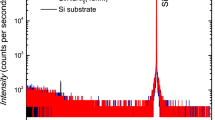Abstract
Arising from C. H. Wan, X. Z. Zhang, X. L. Gao, J. M. Wang & X. Y. Tan Nature 477, 304–307 (2011).10.1038/nature10375
Magnetoresistance exhibited by non-magnetic semiconductors has attracted much attention1,2,3,4,5,6,7,8,9,10,11,12,13. In particular, Wan et al. reported room-temperature magnetoresistance in silicon to reach 10% at 0.07 T and 150,000% at 7 T—“an intrinsically spatial effect”12. Their supply voltage was approximately 10 V (ref. 12), which is low and approaches the industrial requirement14. However, we have found their large magnetoresistance values to be experimental artefacts caused by their method of measurement. The true room-temperature magnetoresistance of the devices described in ref. 12 is low with a magnetic field of up to 7 T and a supply voltage of around 10 V and hence these devices cannot offer large magnetoresistance with low supply voltage to industry. There is a Reply to this Brief Communication Arising by Zhang, X. Z., Wan, C. H., Gao, X. L., Wang, J. M. & Tan, X. Y. Nature 501, http://dx.doi.org/10.1038/nature12590 (2013).
Similar content being viewed by others
Main
Wan et al.12 measured two types of In/SiO2/Si/SiO2/In devices using a Keithley 2400 sourcemeter as both a current source and a voltage meter (which we refer to here as method 1), and obtained large magnetoresistance values of up to 10% at 0.07 T and 150,000% at 7 T. We fabricated two devices with the same structures as those of ref. 12 and performed method 1 using them. Their voltage–current (V–I) curves can be divided into different regions with different resistances, just as in the results of ref. 12. Wan et al.12 claim that injection of minority carriers into silicon causes a p–n junction and the changes in resistance, that large magnetoresistance occurs with applied current in one of the regions (referred as to the transition region), and that the magnetic-field dependence of the magnetoresistance in the transition region is different from those in the other regions. However, when we used another method (here called method 2) with unchanged measuring parameters and different instruments on the devices, the V–I characteristics without the transition region were obtained. The only difference between the two methods is that in method 2 we used the Keithley 2400 only as the current source, with an independent voltmeter (Keithley 2182) as the voltage meter.
Further, we performed both methods on two circuits composed of linear resistors, which were used to simulate the devices. The results indicate that in method 1 the Keithley 2400 itself interferes with the measurement of the specimen and cannot give correct voltage values when the applied current exceeds a certain value and falls in the transition region. Because ref. 12 claims that large magnetoresistances were measured when I was in the transition region, magnetoresistance was defined as [R(B) − R(B = 0)]/R(B = 0) and R = V/I, we conclude that the large magnetoresistance values are really experimental artefacts caused by the interference of the sourcemeter. Method 2 is valid. Using it, we obtained magnetoresistance values for the two devices with supply voltages of 6.7–72 V and 0.79–50 V, respectively. The values are all low and the magnetic-field dependence at all applied currents is the same (above 2 T the field dependence is linear); the magnetoresistance does not exhibit any signs of saturation at fields up to 7 T. The linear dependence without magnetoresistance saturation is the same as for inhomogeneity-induced magnetoresistance7,8,9.
References
Smith, R. A. Semiconductors 2nd edn, Ch. 5 (Cambridge Univ. Press, 1978)
Popović, R. S. Hall Effect Devices Ch. 3 (IOP Publishing, 1991)
Xu, R. et al. Large magnetoresistance in non-magnetic silver chalcogenides. Nature 390, 57–60 (1997)
Solin, S. A., Thio, T., Hines, D. R. & Heremans, J. J. Enhanced room-temperature geometric magnetoresistance in inhomogeneous narrow-gap semiconductors. Science 289, 1530–1532 (2000)
Lee, M., Rosenbaum, T. F., Saboungi, M.-L. & Schnyders, H. S. Band-gap tuning and linear magnetoresistance in the silver chalcogenides. Phys. Rev. Lett. 88, 066602 (2002)
Husmann, A. et al. Megagauss sensors. Nature 417, 421–424 (2002)
Parish, M. M. & Littlewood, P. B. Non-saturating magnetoresistance in heavily disordered semiconductors. Nature 426, 162–165 (2003)
Hu, J. S. & Rosenbaum, T. F. Classical and quantum routes to linear magnetoresistance. Nature Mater. 7, 697–700 (2008)
Delmo, M. P., Yamamoto, S., Kasai, S., Ono, T. & Kobayashi, K. Large positive magnetoresistive effect in silicon induced by the space-charge effect. Nature 457, 1112–1115 (2009)
Delmo, M. P., Kasai, S., Kobayashi, K. & Ono, T. Current-controlled magnetoresistance in silicon in non-Ohmic transport regimes. Appl. Phys. Lett. 95, 132106 (2009)
Schoonus, J. J. H. M., Haazen, P. P. J., Swagten, H. J. M. & Koopmans, B. Unravelling the mechanism of large room-temperature magnetoresistance in silicon. J. Phys. D 42, 185011 (2009)
Wan, C. H., Zhang, X. Z., Gao, X. L., Wang, J. M. & Tan, X. Y. Geometrical enhancement of low-field magnetoresistance in silicon. Nature 477, 304–307 (2011)
Porter, N. A. & Marrows, C. H. Linear magnetoresistance in n-type silicon due to doping density fluctuations. Sci. Rep. 2, 565 (2012)
Allan, A. et al. 2011 edn, http://www.itrs.net/Links/2011ITRS/Home2011.htm (2011)
Author information
Authors and Affiliations
Contributions
J.L. designed the research blueprint, performed the experiments and data analysis, and wrote the manuscript. P.L. and S.Z. assisted in the magnetoresistance measurement and data analysis. H.S. and H.Y. assisted in the data collection. Y.Z. supervised the magnetoresistance measurement and contributed to the data analysis and manuscript writing.
Corresponding author
Ethics declarations
Competing interests
Declared none.
Rights and permissions
About this article
Cite this article
Luo, J., Li, P., Zhang, S. et al. Low-voltage magnetoresistance in silicon. Nature 501, E1 (2013). https://doi.org/10.1038/nature12589
Received:
Accepted:
Published:
Issue Date:
DOI: https://doi.org/10.1038/nature12589
This article is cited by
-
Zhang et al. reply
Nature (2013)
Comments
By submitting a comment you agree to abide by our Terms and Community Guidelines. If you find something abusive or that does not comply with our terms or guidelines please flag it as inappropriate.



